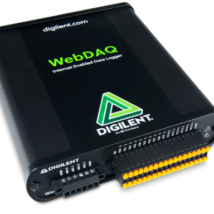WebDAQ-904: Universal input data logger, internet-enabled, with 4 simultaneous channels, 24-bit resolution, 100 S/s/ch max sample rate
The WebDAQ-904 is a stand-alone data logger with universal inputs designed for remote monitoring and control. All the intelligence is built into the WebDAQ, eliminating the need for a PC or additional software. By using the embedded WebDAQ web server, users can easily configure simple or sophisticated applications, log sensor data, update digital outputs and/or send notifications based on alarm conditions, and view real-time data from any location and any device with a web browser.
The WebDAQ 904 performs high-accuracy measurements from up to four analog inputs. Users can measure several signals from sensors such as strain gauges, RTDs, thermocouples, and load cells. Housed in a heavy-duty chassis, the WebDAQ 904 is rugged enough for industrial applications
WebDAQ Web Interface
An embedded web server provides a clean, intuitive interface to access all configuration and data management tasks.
Hardware, trigger and alarm settings are contained in a single task, or “job”. Multiple “jobs” can be run in a “schedule” for more complex data logging applications.
For example, users can create a schedule of jobs in which one job automatically runs after an alarm condition is triggered on a different job, such as when a temperature is reached or when a digital input changes.
Find more details in video and MCC’s website:
Find all our data loggers on our site








